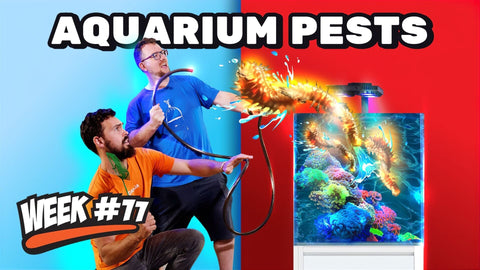Best Starter Fish For Your Reef Tank | 12 Week Reef Video Tutorial #9
Adding Your First Fish with Dr. Yi Kai Tea
In starting a reef tank, creating a healthy and vibrant ecosystem takes time and careful planning. This week, we’re ready to introduce new fish to the 12-week reef, guided by none other than Dr. Yi Kai Tea, an ichthyologist and reef tank expert! Let’s dive into this exciting next step.
Why Add Fish Slowly?
If you're starting a reef tank from scratch, remember that introducing fish gradually is key. In earlier weeks, we added only foundational elements: beneficial bacteria, a clean-up crew, and one hardy blenny. These additions created stability in our tank’s ecosystem, prepping it for more fish. Unlike corals, fish produce more waste, affecting water quality and requiring higher nutrient control. That’s why it’s best to add fish slowly, allowing your tank to adapt as it grows into a proper reef and fish habitat.
Choosing the Best Fish for a Reef Tank
Choosing the best fish to start with isn’t just about finding something that looks cool; it’s about understanding a species’ needs and compatibility with other tank inhabitants. Factors such as temperament, potential size, dietary habits, and coral compatibility are critical. For our 70-gallon 12-week reef, we wanted coral-friendly fish and species that could thrive in a smaller, structured habitat with rock formations and hideouts.
This week, we added three fish: two yellow assessors and one fire goby. These species are colorful, manageable in size, and pose no risk to our corals. Before heading to the fish store, we made a checklist based on Dr. Tea's advice to ensure they’d fit our tank’s ecosystem perfectly.
The Acclimation Process: A Crucial Step
When adding any new fish, especially to a young reef system, best acclimation technique for fishes is essential. Acclimating fish helps them adjust to water parameters, reducing stress and improving survival rates. Dr. Tea led us through a step-by-step process:
-
Float the Bag: We started by floating the fish bags in the tank for about 15-20 minutes to match temperatures gradually.
-
Gradual Mixing: Slowly, we added tank water to the bags over the next 30 minutes to balance water chemistry gently.
-
Careful Release: Finally, we gently released each fish, giving them ample time to explore and find hiding spots. This method keeps stress low and helps the fish acclimate to their new environment safely.
During the acclimation, we chatted with Dr. Tea about his work and his passion for marine life and photography. As an ichthyologist, his expertise in fish biology is unmatched, and he shared invaluable tips for long-term success in starting a reef tank.
Week 9 Recap: Building a Lively Reef
Week 9 is a milestone for our 12-week reef, now bustling with new fish life. We added two yellow assessors and a fire goby, carefully chosen with Dr. Tea's expert guidance. Thanks to the step-by-step acclimation process, they settled in beautifully, ready to thrive alongside our corals. Adding fish gradually has helped our reef tank ecosystem remain stable, setting us up for long-term success.
Tune in next week for Week 10 as we cover more advanced topics, including dosing schedules, nutrient management, and some essential reef maintenance hacks!





